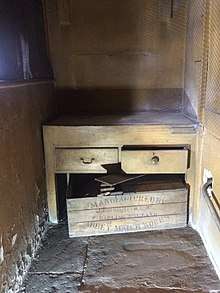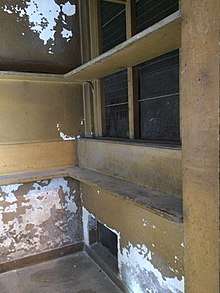Larder
A larder is a cool area for storing food prior to use. Originally, it was where raw meat was larded—covered in fat—to be preserved.[2] By the eighteenth century, the term had expanded. Now a dry larder was where bread, pastry, milk, butter, or cooked meats were stored.[2] Larders were commonplace in houses before the widespread use of the refrigerator.

Stone larders were designed to keep cold in the hottest of weather. They had slate or marble shelves two or three inches thick. These shelves were wedged into thick stone walls. Fish or vegetables were laid directly onto the shelves and covered with muslin or handfuls of wet rushes were sprinkled under and around.[3]
Essential qualities
Description
In the northern hemisphere, most houses would be arranged to have their larders and kitchens on the north or west side of the house[2] where they received the least amount of sun. In Australia and New Zealand, larders were placed on the south or east sides of the house for the same reason.

Many larders have small, unglazed windows with the window openings covered in fine mesh.[2][1] This allows free circulation of air without allowing flies to enter. Many larders also have tiled or painted walls to simplify cleaning. [1] Older larders, and especially those in larger houses, have hooks in the ceiling to hang joints of meat.[1]
A pantry may contain a thrawl, a term used in Derbyshire and Yorkshire to denote a stone slab or shelf used to keep food cool in the days before refrigeration was domestically available. In a late medieval hall, a thrawl would have been appropriate to a larder. In a large or moderately large nineteenth-century house, all these rooms would have been placed in the lowest—and/or as convenient—possible location in the building in order to use the mass of the ground to retain a low summer temperature. For this reason, a buttery was usually called the cellar by this stage.
Larder is also now used to describe the underwater storage place used by alligators and crocodiles for their fresh kills until such time as they wish to consume the meal when it's rotten. They usually are dug into the side of a land bank, or wedged under a log or tree root.
Etymology
Middle English (denoting a store of meat): from Old French lardier, from medieval Latin lardarium, from laridum.[4]
History
In medieval households, the word "larder" referred both to an office responsible for fish, jams, and meat, as well as to the room in which these commodities were kept. It was headed by a larderer.[5]The Scots term for larder was spence,[6] This referred specifically to a place from which stores or food were distributed.[2] And so in Scotland larderers (also pantlers and cellarers) were known as spencers.
The office generally was subordinated to the kitchen and existed as a separate office only in larger households. It was closely connected to other offices of the kitchen, such as the saucery and the scullery.[7]
Larders were used in the Indus River Valley to store bones of goats, oxen, and sheep. These larders were made of large clay pots.[8]
See also
References
| Look up larder in Wiktionary, the free dictionary. |
- Davies, Jennifer. (1989). The Victorian kitchen. London: BBC Books. ISBN 0563206853. OCLC 21182995.
- The country house kitchen. Sambrook, Pamela., Brears, Peter C. D., National Trust (Great Britain). Stroud: History. 2010. ISBN 9780752455969. OCLC 495598875.CS1 maint: others (link)
- Hartley, Dorothy. (2009). Food in England. London: Piatkus. ISBN 9780749942151. OCLC 319209748.
- "Larder". Oxford Dictionaries. Oxford University Press. Retrieved 2 March 2016.
- "History of Pantry: The room used as a storage for food and beverage in every household since the Middle Ages". Walls with Stories. 2017-07-17. Retrieved 2019-05-21.
- "Spence". Dictionary of the Scots Language. Retrieved 2 February 2016.
- Woolgar, C. M. (1999). The Great Household in Late Medieval England. New Haven and London: Yale University Press. pp. 111, 144. ISBN 0-300-07687-8.
- Mackay, Ernest John Henry (1948). Early Indus Civilizations (hardcover ed.). Luzak. p. 142. ASIN B0007IUIPM.